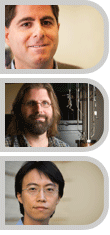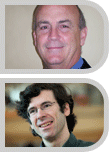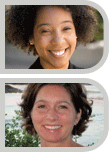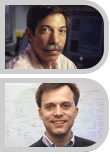Faculty Research & Honors
Selected Faculty Research
- New Insights into Graphene
- David A. Muller, Applied and Engineering Physics; Paul L. McEuen, Physics; and Jiwoong Park, Chemistry and Chemical Biology
- Developing Methods to Identify Terrorist Social Networks
- Matthew E. Brashears, Sociology
- Homeless Dogs and Melancholy Apes
- Laura S. Brown, English
- Starving Cancer Cells
- Richard A. Cerione, Molecular Medicine/Chemistry and Chemical Biology
- Secondhand Cigarette Smoke Unsafe
- Ronald G. Crystal, Medicine
- A Sustainable Future
- Frank DiSalvo, Chemistry and Chemical Biology
- Networks, Crowds, and Markets
- David A. Easley, Economics, and Jon M. Kleinberg, Computer Science
- Improving Disability Employment Practices
- Susanne Bruyére, Lisa Nishi, and Kevin Hallock, School of Industrial and Labor Relations
- Government Action
- Sherry L. Martin and Jessica L. Weeks, Government
- Sounds of Animated Things Breaking
- Doug L. James, Computer Science
- Studying Microbes in the Gut
- Ruth E. Ley, Microbiology
- A Robot’s Hand
- Hod Lipson, Mechanical and Aerospace Engineering/Computing and Information Science
- Digging into Data
- Mats Rooth, Linguistics
- Bach in Its Element
- Annette Richards, Music
- Fabric for Online Security
- Fred B. Schneider and Andrew C. Myers, Computer Science
New Insights into Graphene

Graphene, a single atomic layer form of carbon, has the potential to improve anything from solar cells to cell phone screens. Cornell researchers David A. Muller, Applied and Engineering Physics; Paul L. McEuen, Physics; and Jiwoong Park, Chemistry and Chemical Biology, revealed atomic-resolution details of graphene “quilts”—sheets of carbon one atom thick, stitched together at tilted interfaces—and how they look at the boundaries between patches. The researchers found that growing bigger patches did not improve the electrical conductivity of the graphene, as materials scientists previously believed, but that impurities get into the sheets, making the electrical properties fluctuate. These key insights into graphene’s mechanical and electrical properties will lead scientists closer to the best ways to grow and use graphene.
Developing Methods to Identify Terrorist Social Networks

Matthew E. Brashears, Sociology, received a three-year grant of $797,000 from the Defense Threat Reduction Agency to develop methods of identifying covert social networks that could be used by terrorists, human traffickers, or drug smugglers. His research will investigate why transnational terrorism emerges and how the supply of terrorists can be cut off, instead of just finding individual terrorists once they act. He will also develop a method to identify the first person in a network. His goal is to replace profiling techniques currently in use with more reliable methods for detecting terrorist cells that are preparing to attack.
Homeless Dogs and Melancholy Apes

With the discovery of the great apes and the rise of bourgeois pet keeping, human-animal relations underwent a change in 18th-century England. In her new book, Homeless Dogs and Melancholy Apes: Humans and Other Animals in the Modern Literary Imagination (Cornell University Press, 2010), Laura S. Brown, English, shows how these historical changes created a new cultural and intellectual context for understanding and representing animalkind, which has played a significant role in imaginative literature ever since. Brown illustrates how writers first used their nonhuman characters—from the lapdogs of Alexander Pope to the ill-mannered monkey of Frances Burney’s Evelina and ape-like Yahoos of Jonathan Swift—to explore human identity and self-definition, human love and the experience of intimacy, and human diversity and the boundaries of convention.
Starving Cancer Cells

Richard A. Cerione, Molecular Medicine/Chemistry and Chemical Biology, and his research team discovered a molecule that can block cancer cells from using glutamine, an amino acid needed for cancer cell growth and vitality. The finding could lead to a new class of cancer-fighting drugs. Researchers have long believed that starving cancer cells of glutamine would help to fight some cancers, but have struggled with how to accomplish it. These Cornell researchers discovered a molecule they dubbed 968, which binds to the enzyme glutaminase and inhibits cancer growth by blocking the cancer cells’ ability to use glutamine.
Secondhand Cigarette Smoke Unsafe

Ronald G. Crystal, Medicine, and physician-scientists at Weill Cornell Medical College found that infrequent smokers and people exposed to secondhand smoke are at risk for future lung diseases, such as lung cancer and chronic obstructive pulmonary disease (COPD). The researchers discovered that even at the lowest detectable levels of exposure to cigarette smoke, there are direct effects on the functioning of genes within the cells lining the airways. No level of smoking or exposure to secondhand smoke is safe. This is the first study to provide conclusive biological tests demonstrating what secondhand smoke and low-level smoking do to the body at the level of gene function.
A Sustainable Future

The Cornell Center for a Sustainable Future got a new name, the David R. Atkinson Center for a Sustainable Future, in October 2010. The center received the largest single gift from an individual to Cornell’s Ithaca campus: $80 million from David R. Atkinson ’60 and Patricia Atkinson. Providing “a permanent base for stimulating and coordinating Cornell’s unfolding capabilities in sustainability,” the historic gift helps position Cornell to become a global leader in sustainability research, education, and outreach. Frank DiSalvo, Chemistry and Chemical Biology, directs the center.
Networks, Crowds, and Markets

David A. Easley, Economics, and Jon M. Kleinberg, Computer Science, study how the social, economic, and technological worlds are connected. In their new book, Networks, Crowds, and Markets: Reasoning about a Highly Connected World (Cambridge University Press, 2010), they look at networks, incentives, and the aggregate behavior of groups of people: for example, the rapid growth of the internet and the web, the ease of global communication, and the ability of news and information, epidemics, and financial crises to spread swiftly around the world. The authors apply different scientific perspectives—economics, sociology, computing and information science, and applied mathematics—to broad questions about networks and behavior.
Improving Disability Employment Practices

The Employment and Disability Institute in Cornell’s School of Industrial and Labor Relations won a grant of $4 million to study differences in employer practices in hiring, advancing, and retaining people with disabilities. The study seeks to answer some key questions: What kind of manager is most effective at implementing disability policy? Can organizations help people with disabilities feel more engaged and fully utilized at work? How can employers be better equipped to recruit and retain people with disabilities, including returning veterans? Several centers and external partners, including ILR’s Center for Advanced Human Resource Studies and Institute for Compensation Studies, are contributing to the project. The study will inform targeted interventions to improve employer practices. Susanne Bruyére directs the institute, and Lisa Nishi leads research in the institute. Kevin Hallock directs the Institute for Compensation Studies.
Government Action

Sherry L. Martin, Government, was awarded a Fellowship for Advanced Social Science Research on Japan from the U. S. National Endowment for the Humanities to pursue her comparative project, “Mobile Knowledge: Adult Learning and Politics in Japan, Sweden, and the United States.” Jessica L. Weeks, Government, was awarded a Junior Faculty Research Grant from the Smith Richardson Foundation for her book project, Dictators at War, which examines how domestic politics affects decisions of authoritarian leaders concerning war, peace, and international cooperation.
Sounds of Animated Things Breaking

Doug L. James, Computer Science, and his graduate student have learned to synthesize the sounds of smashing brittle materials to match computer-animated images. To create a perfectly matched sound, they consider the computer graphic model underlying the animation and calculate how a corresponding real object would vibrate when fractured and how that vibration would create sound. The researchers integrate their computation of appearance, motion, and sound, instead of adding the sound afterward. For years, filmmakers have dubbed in recorded sound, but it is difficult to get the sound effects to match the action. In a game or virtual reality, programmers cannot know in advance just how hard or far an object will fall. This is the first time computer-synthesized models of these events have been built with sound.
Studying Microbes in the Gut

Ruth E. Ley, Microbiology, asks basic questions about the world of microbes in the gut. With a 2010 Packard Fellowship in Science and Engineering of $875,000, she will study the genes of twins to understand how gut microbes coevolved with humans and their diets. With a 2010 National Institutes of Health New Innovator grant of $1.5 million, she will investigate the relationship between chronic disease and microbes in the gut. In 2009, Ley received a Beckman Foundation Young Investigator award for her work on how defensins, antimicrobial peptides produced in the intestine, influence the diversity of bacteria in the gut. Ley thinks that people’s mix of microbes—which outnumber human cells ten to one in the body—could be just as important to their health as their genes.
A Robot’s Hand

Hod Lipson, Mechanical and Aerospace Engineering/Computing and Information Science, and research collaborators created a versatile robotic gripper using ground coffee and a latex party balloon, instead of traditional designs based on the human hand. The researchers call their creation a universal gripper because it conforms to the object it is holding, rather than fitting just one object. The gripper has limitless future applications, including robotic arms in factories, robot feet that could walk on walls, and prosthetic limbs. The military could use the gripper to dismantle explosive devices or move dangerous objects.
Digging into Data

Mats Rooth, Linguistics, is one of eight winners of an international competition, Digging into Data. Participants were challenged to devise innovative humanities and social sciences research projects that employ large-scale data analysis. Rooth’s project, “Harvesting Speech Databases for Linguistic Research,” scans the internet to study how we really say things. Rooth uses software to distinguish prosody (rhythm, stress, and intonation) in language by hunting online for word patterns, harvesting hundreds of thousands of examples of spontaneous—rather than lab-created—word patterns. His work will enable researchers to evaluate theories about the form and meaning of prosody on an unprecedented scale, transforming the understanding of an important branch of linguistics.
Bach in Its Element

Annette Richards, Music, led an international, multidisciplinary project to build an organ at Cornell in the “style and scope appropriate to the music of noted German organist composers of the 17th and 18th centuries, particularly Johann Sebastian Bach.” This world-class instrument was unveiled in November 2010 in Anabel Taylor Chapel. The organ was constructed using authentic 18th-century techniques, and it has many voices—“powerful, sweet, lovely, tender, proud.” The dedication of this historic organ took place March 2011 with a concert festival and a major conference, Keyboard Culture in 18th-Century Berlin and the German Sense of History. Cornell’s new Baroque organ was a decade in the making, promoted by an international team of more than 100 researchers and artisans.
Fabric for Online Security

Fred B. Schneider and Andrew C. Myers, Computer Science, are developing a way to build security into computer systems from the start—by incorporating security into the language used to write the programs, rather than trying to patch a hacked system. Their new development, dubbed Fabric, is a platform and programming language designed to create secure systems for distributed computing, where many interconnected nodes (locations on a computer network) are involved, such as in systems that move money or maintain medical records. For example, when you connect to Amazon, it talks to your credit card company and the vendor of the product, passes your demographics to some advertisers and more. Nodes in Fabric pass around objects that contain data and program code, but the objects have built-in rules about how each node can interact with them. The Fabric language requires programmers to include these rules and saves them the work of writing code to enforce them.
